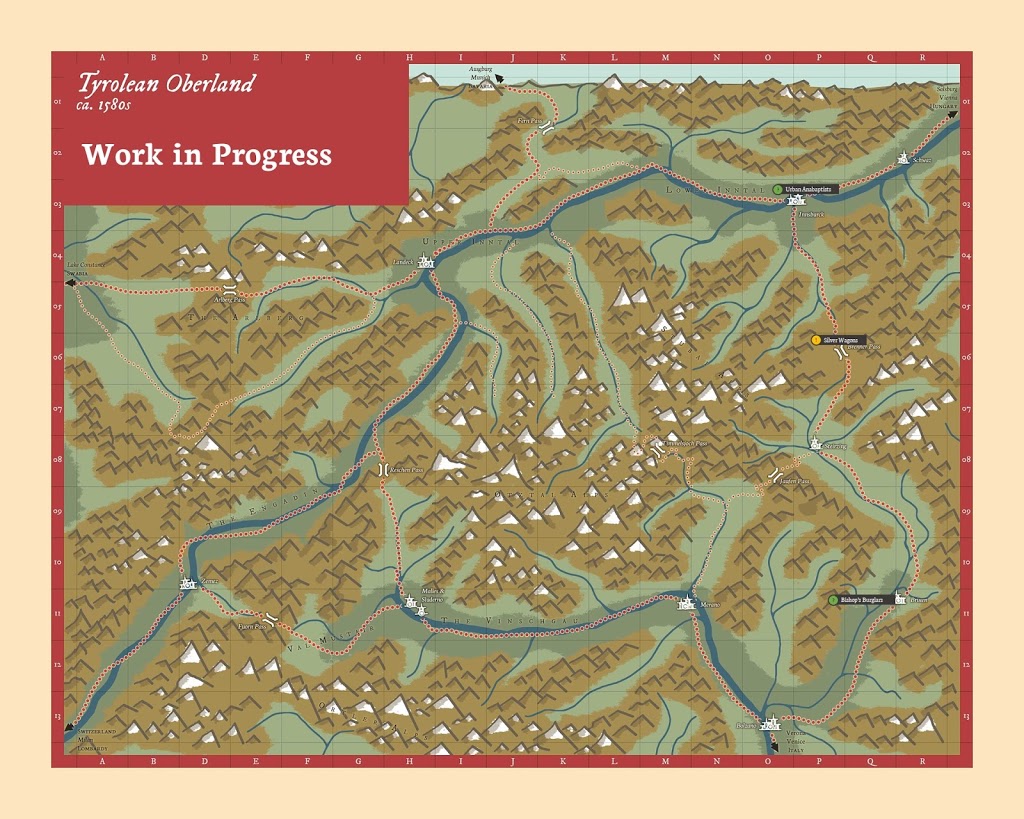As I develop my d20/OSR-inspired rules, I’m also looking at both the campaign premise and setting. Though my primary historical focus is on the Renaissance Netherlands, I don’t want that to be the campaign setting for two reasons:
- To keep my players (most of whom will be my friends) from feeling clubbed over the head with yet another instance of my ongoing interest in Dutch history.
- To keep my own obsessive desire to get the historical context and details right from overwhelming prepping for and actually playing the game. An area of Europe I’ve researched less should hopefully give me permission to not be so pedantic!
What to Expect from the Campaign?
- Played with the
d20/OSR-inspiredrules I am developing for historical games set in Late Renaissance Europe, specifically the Austrian Alps of the mid-1570s (see following for an introduction to the setting) - A West Marches-inspired campaign structure, that is, supporting a rotating cast of players dropping in & out and sandbox-style options for adventures based on the players’ choices
- Monthly (or occasionally bimonthly) games of an evening or weekend afternoon
- Preference of roleplaying over highly tactical combat; some sessions may contain no battles at all
- OSR-style play focused on player decisions (rather than stats on a sheet) and good faith trust in GM fiat resulting from a lightweight rules set.
- An homage to the historical context without being overly stringent about complete fidelity to the history or society (i.e. I have no desire to make the game suck if you play a female, foreign, and religiously deviant player character).
- Likewise, players should expect a historically-set game (e.g. no magic), they won’t be burdened by extracurricular historical reading just to understand what’s happening in-game.
- Player characters are assorted courtiers, ruffians, and adventurers taking on jobs, doing favors, and otherwise solving problems for the Archduke Ferdinand II, his wife Philippine Wesler, and the Prince-Bishop of Brixen.
Setting: Tyrolean Highlands, c. 1570s
The following is my initial draft of a campaign introduction for prospective players. It’s likely to be revised as the 15XX rules make it to a playtest-ready state.

Nestled in the depths of the Eastern Alps is the oberlandof the County of Tyrol, ruled over by Ferdinand II, Archduke of Austria.
A true Renaissance prince, he married a merchant’s daughter for love (Philippine) and is renowned for his collection of art. As younger brother to the Holy Roman Emperor, though, Ferdinand is often away in Vienna or Prague, and the administration of the region is left to his well-beloved wife and privy counselors… who often have need of brave, disposable men and women to “see to things.”
Such adventurers are also of use to Johann Thomas von Spaur, the Prince-Bishop of Brixen, another worldly man from a powerful Tyrolean family. While his relations with the Archduke are cordial – built upon a bedrock of Counter-Reformation zeal – the prince-bishop would rival his Hapsburg master if he could, both politically and in the humanist acquisition of books, art, and fine palaces.
These two men represent an uneasy, Catholic alliance for culture and stability in the region. Between them are the wealthy Fugger family (with vested interests in open trade and mining profits) and the host of remote towns and villages scattered deep among the Alpine valleys, all of which call on either the Archduke or Prince-Bishop in times of trouble.
This mountainous realm is something of a backwater, save for the Brenner Pass which links Innsbruck (home of the Archduke) to Brixen (seat of the Prince-Bishopric) by way of Steirzing (home itself to a sizable number of merchants and muscle of the Fuggers). More importantly, the Pass is the chief trade route in the Eastern Alps, linking Venice to Germany.
This creates the fundamental tension in the Oberland.
Merchants, pilgrims, soldiers, and statesmen – and no small share of highwaymen – flood the cities and the Pass on its eastern edge while the towns and villages nestled in river valleys to the west are left to linger, threatened by the machinations of disgruntled landherren, the influence of the Anabaptists (and worse still), and the persistent threat of the fanatical Swiss-aligned Three Leagues.
No small wonder such powerful figures have need of capable, adventurous types.

